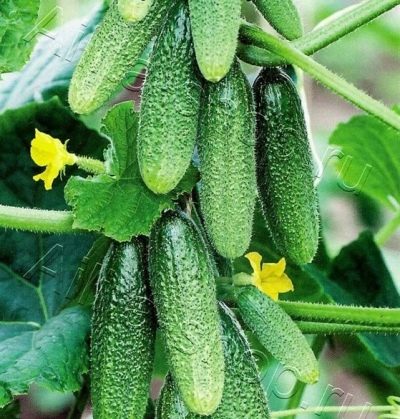
- Growth type: indeterminate
- Fruit weight, g: 70-90
- Fruit length, cm: 9-12
- Fruit color: green
- Ripening terms: mid-early
- Fruit shape: oval-cylindrical
- Fruit taste: excellent, no bitterness
- Appointment: universal
- Pulp (consistency): crispy
- Parthenocarpic: Yes
Cucumber Vse bunch - a hybrid with a perky name, suitable for industrial cultivation, and for cultivation for personal purposes. Decent presentation, excellent taste and consistently high yield attract the attention of many vegetable growers.
Description of the variety
The parthenocarpic hybrid can be grown both in greenhouses and in open beds. The variety is characterized by resistance to diseases and pests, as well as abundant and long-term fruiting. In addition, cucumbers of this variety are suitable for all culinary purposes.
Characteristics of the appearance of plants and zelents
Indeterminate shrubs reach an average height (maximum 2.5 m). The branchiness of plants is small. Leaves are ordinary, green, with wavy edges. The fruits grow in bunches of 2-4 cucumbers. This is the reason for the name of the hybrid. The shape of the zelents is cylindrical, with small tubercles. The weight of one fruit can reach 90 g. The average length of cucumbers of this variety is 9-12 cm.
Purpose and taste of fruits
The taste of Zelentsov is pleasant, has no bitterness at all. Therefore, the use of the fruit is universal. Cucumbers are good in slices, salads and other fresh snacks. They are also great for whole-fruit canning (pickling and pickling).
Maturation
The variety is considered medium early. Seeds are sown for seedlings at the end of April. At the age of 30 days, the plants are transferred to a permanent place. From the appearance of the first sprouts to the start of picking cucumbers, 46-50 days pass.
Yield
The variety is highly productive. Each square meter can yield up to 15 kg of cucumbers. Fruiting lasts a long time. Fruits tolerate storage and transportation well.
Landing scheme
When planting seedlings in the ground, it is recommended to adhere to the 50x40 cm scheme. This allows you to avoid thickening of the plants and get the maximum yield. Also, this arrangement of the bushes provides the grower with comfort when picking fruits, watering and loosening.
Growing and caring
Despite the resistance of the variety to various weather conditions, it is better to choose a well-lit area for cultivation, inaccessible to strong winds. Growing bushes should be tied to a support and formed into one stem. As for the side shoots, they need to be pinched over the second or third leaf.
Watering the hybrid is necessary every 2 days. In dry weather, irrigation is carried out daily. Moistened soil should be loosened periodically. This should be done once every 2 weeks. Fertilizers are applied 5 times per season:
- when forming 2 full sheets, a urea solution is used;
- then the cucumbers are fertilized 3 times with superphosphate and potassium salt (every 14 days);
- the last feeding (nitrogen fertilization) is done after the first harvest.
Soil requirements
It is desirable that the soil is nutritious. To do this, in the fall, it is dug up and fertilized with organic matter. In the spring, before planting cucumbers, weeds are removed and the topsoil is loosened.It is also useful to enrich the beds with potassium and phosphorus.

In order to collect strong, tasty and beautiful cucumbers on your site, you need to make top dressing. Lack of nutrients can negatively affect the appearance of the plant and significantly reduce the yield. Fertilize cucumbers with organic fertilizers in combination with mineral fertilizers. With the right balance of these components and adherence to the fertilizing schedule, the cucumber yield will be maximum.
Disease and pest resistance
This variety is resistant to cladosporia and downy mildew. However, the culture can be susceptible to vascular bacteriosis. If a disease is detected, the bushes should be immediately treated with a copper-containing preparation. If pests attacked cucumbers, the appropriate chemical compositions come to the rescue.

Despite their popularity, cucumbers are often attacked by diseases and pests. From them, cucumber plantings often die before the start of fruiting. In order to prevent this from happening, it is necessary to try to prevent ailments or get rid of them at the very beginning, having studied in detail their causes of occurrence, signs and methods of treatment.
Review overview
Growers report that the variety begins to bear fruit quite early. There are many cucumbers. The taste of the crop is pleasing. The only caveat is the impossibility of self-collecting seeds for planting next season. However, most summer residents do not consider this a serious drawback.





























































































